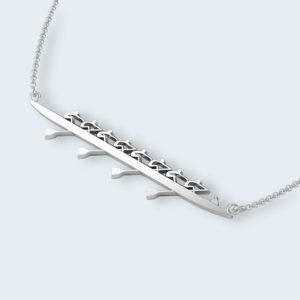This series looks at the areas which can supplement your training to maximise your performance and show you how you can be your own support team.
2: Flexibility
In this article we look at the benefit of flexibility to rowers, and how you can test and improve your own flexibility.
How does Flexibility affect rowers?
The main area of the stroke where flexibility is important is the catch. To a certain degree a longer stroke will be more effective in moving the boat, provided that the catch position is strong and the rower is capable of pressing the legs effectively from this position. This point is important. As rowers we do not necessarily want the longest possible stroke, where we are over-compressed and cannot turn this length into an effective stroke, but we do want to be comfortable, strong and controlled in getting to the longest effective catch position possible.
When watching rowers who are new to the sport they often do not get to full compression at the catch and many will rush into the catch before ‘bouncing’ away from the catch position. The limit on stroke length shows poor flexibility of hamstrings and hips. The bounce off the catch happens because the legs and hips are not flexible enough to move into and out of the compressed catch position with control; the rowers force themselves into the catch position by rushing forwards. By forcing the body towards the stern the rower does not let the boat run smoothly, instead pulling the boat underneath their bodies and accelerating weight towards the stern. This reduces the efficiency of the recovery. On the drive, the change of direction at the catch happens as a reaction to overstretched muscles rather than a drive from the legs. The initial part of the drive is not powered because the rower is not in a position where they are able to effectively press the legs.
Ankle flexibility will determine how much a rower’s heel will lift off the stretcher at the catch position. This distance of lift should be minimised to ensure that leg power is pressed through the heel as early as possible in the drive.
Flexibility comes into play not just in stroke length and application of power but also in body position. Tight hamstrings and inflexible hips limit the forward lean of rowers away from backstops. Rowers limit their length by not getting the shoulders sternward of the hips on the recovery, or they compensate by increasing body-lean as they slide toward the catch. Sitting too upright limits length and reduces the effectiveness of the legs on the drive as the core and back muscles have to work to hold the body upright. Rowers may tend to open their body angle too early and this can lead to back injuries. Rowers who get their body lean as they slide will add weight to the stern during the recovery, affecting the run of the boat, and are likely to ‘crash’ the upper body over into the catch before opening the body angle too early on the drive.
“Flexibility is a key factor in allowing you to get into the best body position at the catch, and in achieving a long, strong, and powerful rowing stroke. Tight hamstrings limit your ability to achieve this ideal body position.”
Bob Kaehler – www.coachkaehler.com/new/2011/01/02/improving-your-hamstring-flexibility
How Flexible do rowers need to be?
There are arguments that being too flexible limits muscle performance. Coach Kaehler poses the question ‘How Flexible do Rowers Need to be?’ in this article. The consensus seems to be that enough flexibility is needed for rowers to be able to attain a long and effective catch position through smooth, controlled and relaxed movements.
The catch is the most compressed position in the stroke and getting to the right catch position requires stretch from the hamstrings. Rowers should primarily be looking for leg, ankle and hip flexibility as these relate most to the catch position. Rowers should aim to get their forward body lean through hip rotation which will stretch the hamstrings rather than the back. Other parts of the stroke do not require much flexibility, although a good general level of flexibility, particularly in the shoulders, will aid in relaxation and smooth movements.
Flexibility also plays a part in stability and smoothness. If you are flexible enough to move through the recovery with relaxed muscles, instead of forcing your body to achieve the right positions, then you will move with greater ease and fluidity, and be able to adapt to imbalances caused by external factors (wind, waves). Flexibility also helps to prevent injuries to over-stretched, tense muscles.
How can you Test your Flexibility?
Hips Quads: The Thomas Test
This video shows how to perform the Thomas Test which gives a good assessment of hip flexors and rectus fermoris, one of the muscles of the quadricep.
Hamstrings:
For rowers it is important to perform the following reaching tests with a straight back, getting lean from hip rotation and not arching the back, as this is the movement we are looking for in the boat.
– Sit Reach Test:
– Toe Touch Test:
http://www.youtube.com/watch?v=O7C3DdvnCbI feature=relmfu
– Lying Flexibility Test:
Ankle Mobility Test:
This video shows how to test ankle mobility. More flexible ankles will allow the knee to move further in front of the toes while keeping the heel on the ground.
Shoulders: Range of Motion Test
For rowing specific movement, the shoulders need to be flexible enough to allow the proper movement of the scapula (shoulder blade) as the arm is lifted in the movement out towards the catch, and as it is drawn through to the finish. The shoulder joint should remain low through the stroke. Poor flexibility or weakness in the muscles is revealed by the shoulder joint lifting (impingement) during the stroke.
This video shows how to test for shoulder impingement.
This video shows how to test for proper scapula movement as the arm is lifted.
Shoulders: Overhead Mobility Test
Shoulder movement is also important for supplementary exercise, such as weight lifting and circuit training. Overhead squats, snatch lifts and press-ups rely on good shoulder flexibility and range of motion.
To test your range of motion follow the test demonstrated in this video.
How can you Improve your Flexibility?
Stretching is a simple way to improve muscle and joint flexibility. It is best done when muscles are warm. After your general warm-up and immediately after exercise are ideal times to stretch.
Row2k.com provide a great resource on “Stretching for Rowers” from a US Rowing presentation on Sports Physical Therapy: www.row2k.com/physio/overvie1.html
Other advanced stretches and exercises include:
Hip Stretches:
Hip Exercises for Improved Compression (Rowing Specific):
Glute Exercises:
Ankle Mobility Exercises:
Shoulder – Range of Motion Exercises (for Impingement):
Shoulder – Overhead Mobility Exercises:
Many of these exercises use exercise bands such as Thera-Band and Dynaband to produce resistance. There are many brands of this type of product available and they can be purchased at physiotherapy supply stores.
Remember that our objective should be to improve flexibility in order to maximise boat speed. The Rowperfect software shows your stroke length data and, combined with Joules per stroke, can be used to track improvements in flexibility which directly relate to rowing performance.
Yoga is an excellent way to develop flexibility to achieve positions of stretching and compression while maintaining stability and smoothness of movement. Our book ‘Yoga for Rowers’ provides step-by-step instructions on a range of yoga exercises specifically chosen for rowers to improve their position, balance and flexibility through the full stroke cycle. It is available as a book or an e-Book from the RowPerfect shop.
Related articles
- Drills and Exercises for Rowing and Sculling – Slide Progression from Front-Stops
- Cross-Training for Rowers
- Warming up for Rowing – How to get it right Part 3







